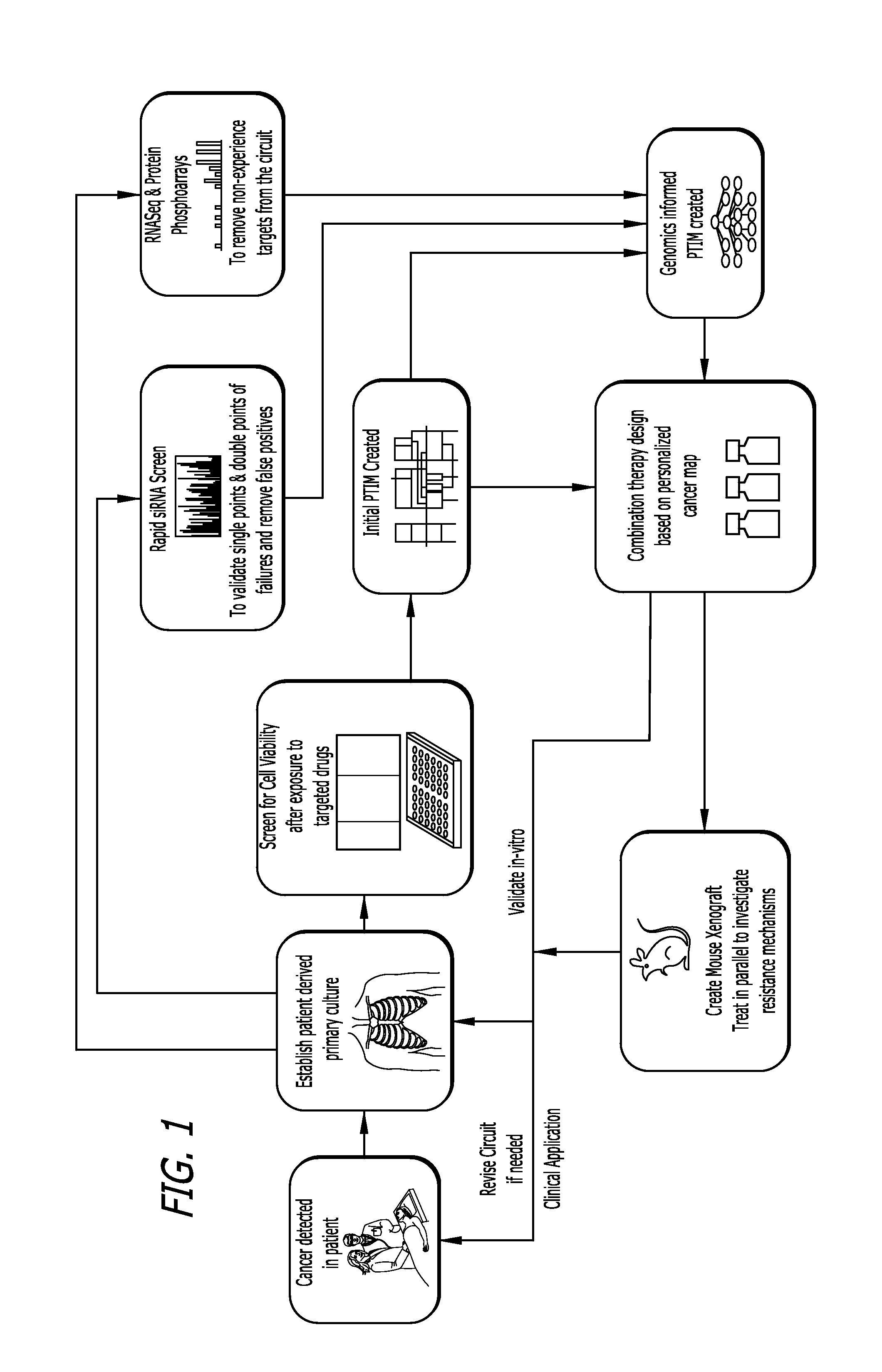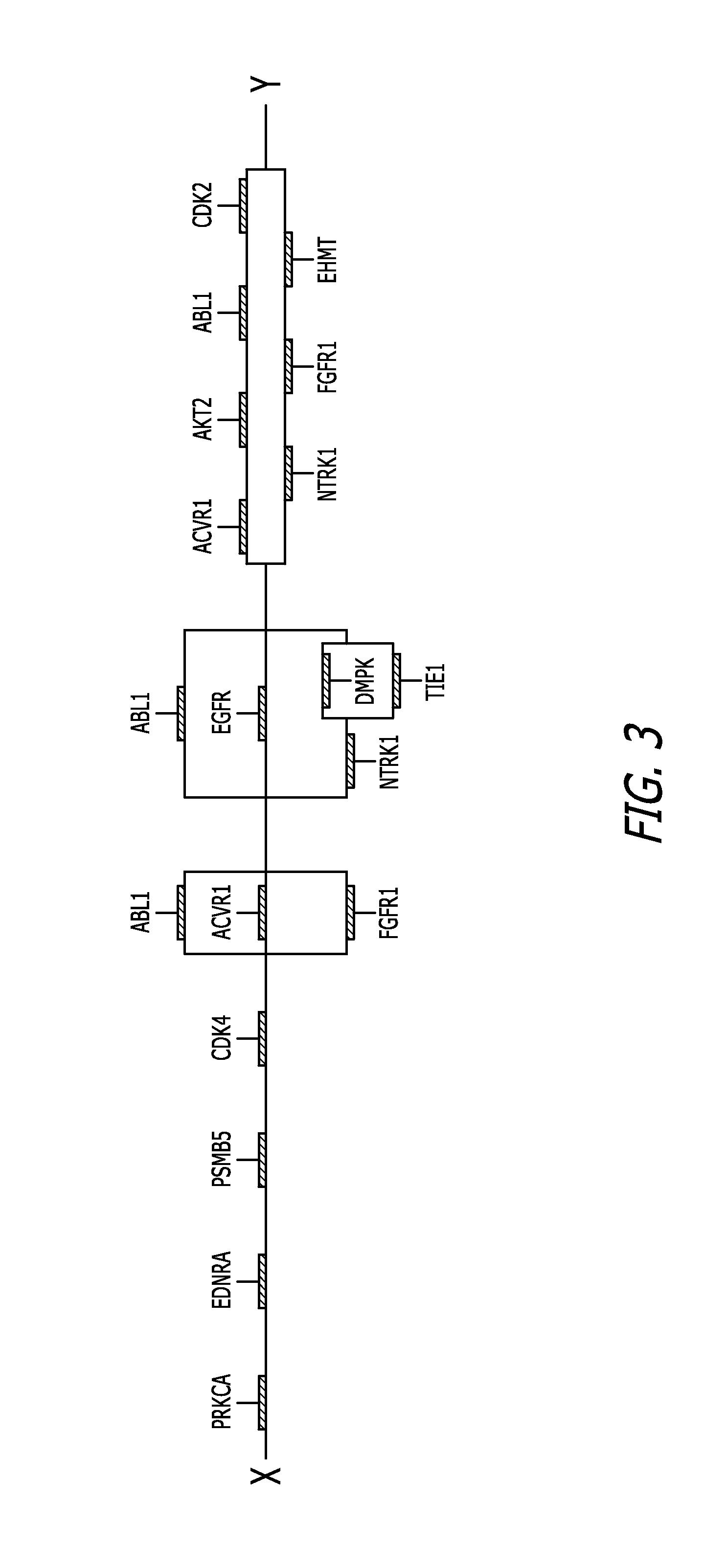Target inhibition map system for combination therapy design and methods of using same
a target inhibition and combination therapy technology, applied in the field of drug sensitivity prediction, can solve the problems of no chemotherapeutic or biological agents that have proven clearly beneficial for the treatment, no active clinical trials open for children with these lethal brain tumors, and significant backlog of novel therapeutics to potentially test in clinical trials, etc., to achieve the effect of increasing the inhibition of oncogenic targets, low sensitivity prediction error, and high accuracy sensitivity prediction
- Summary
- Abstract
- Description
- Claims
- Application Information
AI Technical Summary
Benefits of technology
Problems solved by technology
Method used
Image
Examples
example 1
Pre-Clinical Evaluation of BMS-754807, an IGF-1R Inhibitor in a Genetically Engineered Diffuse Intrinsic Pontine Glioma Mouse Model
[0106]Diffuse intrinsic pontine gliomas (DIPGs), which arise at a median age of 6-7 years old, represent a particularly lethal type of brain cancer with no effective therapeutic options. It has been previously reported the development of a DIPG mouse model which closely mirrors the human condition using the RCAS / tv-a system. This model serves as an accurate platform in which to test novel therapeutics prior to the initiation of costly human clinical trials. In this example, an in vitro high throughput drug screen as part of the DIPG preclinical consortium identified BMS-754807 as a drug of interest in DIPG. BMS-754807 is a potent and reversible small molecule tyrosine kinase inhibitor of the IGF-1R. In vitro evaluation showed significant cytotoxic effects at clinically achievable concentrations with an IC50 of 0.19 μM, and significant inhibition of proli...
example 2
Probablistic Boolean Modeling of Target Synergies from Integrated Chemical Screens and Genomics
[0136]Using an unbiased GSK orphan kinome screening drug library, as well as additional biological data generated from a single test patient sample, nonlinear probabilistic Boolean models describe the evidence-based mechanisms likely resulting in growth inhibition following drug application. The generated models were independent of existing research on disease of choice, alveolar rhabdomyosarcoma, and were generated using only data created exclusively for the pseudopatient of this study. Based primarily on the screen data, and refined by incorporation of transcription abundance data, two nonlinear models were selected for in vitro validation. Both models identified targets implicated in the IGF1R signaling pathway, consistent with existing research on alveolar rhabdomyosarcoma. The expression-naïve PTIM model identified a combination of IGF1R / INSR / PRKACA as being a group of synergistic mec...
example 3
Predictive Analysis to Identify Relevant Targets for Therapeutic Intervention
[0162]Provided herein are methodologies and results for a computational model of drug sensitivity designed to identify relevant functional targets in DIPG utilizing the Probabilistic Target Inhibition Map (PTIM) approach to generate multivariate blocks of targets whose joint inhibition is predicted to increase drug sensitivity. This approach incorporates only functional drug screen sensitivity values with available RNAseq expression data to identify key functional targets in the disease cohort.
Data Pre-Processing and Notations.
[0163]For this analysis, a total of 6 samples were considered that had both drug sensitivity and RNA expression data. A subset consisting of 8 cell lines was tested on Drug Screen 1 (SU-DIPG-IV, SU-DIPG-VI, VU-DIPG.A, NEM-145, NEM157) and another subset of 7 cell lines was tested on Drug Screen 2 (NEM-163, NEM-165, NEM-168, NEM-175, JHH-DIPG1, NEM-157, NEM-215) with 2 cell lines teste...
PUM
| Property | Measurement | Unit |
|---|---|---|
| pH | aaaaa | aaaaa |
| pH | aaaaa | aaaaa |
| exposure time | aaaaa | aaaaa |
Abstract
Description
Claims
Application Information
 Login to View More
Login to View More - R&D
- Intellectual Property
- Life Sciences
- Materials
- Tech Scout
- Unparalleled Data Quality
- Higher Quality Content
- 60% Fewer Hallucinations
Browse by: Latest US Patents, China's latest patents, Technical Efficacy Thesaurus, Application Domain, Technology Topic, Popular Technical Reports.
© 2025 PatSnap. All rights reserved.Legal|Privacy policy|Modern Slavery Act Transparency Statement|Sitemap|About US| Contact US: help@patsnap.com



